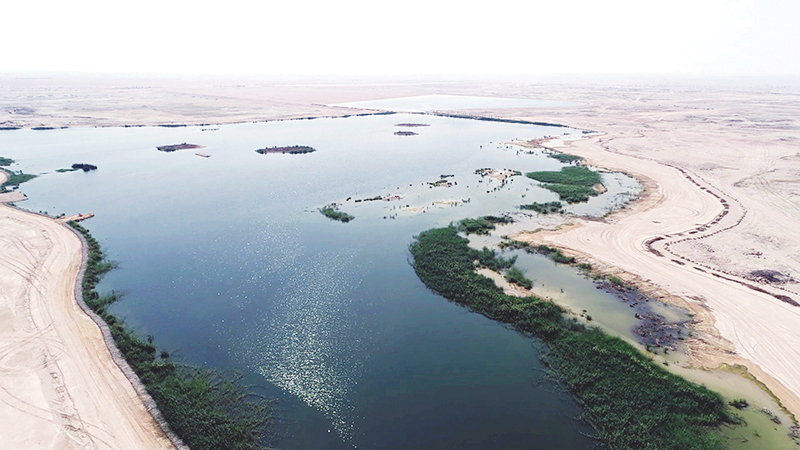
Dr. Eng. Saad bin Ahmad Al Muhannadi, President of Ashghal; Eng. Ahmed Mohammed Al Sada, Assistant Under-secretary for Environmental Affairs at the Ministry of Municipality and Environment; Safar Mubarak Al Shafi, Assistant Under-secretary for General Ser
The Public Works Authority (Ashghal) announced, yesterday, the completion of works of the reclamation and rehabilitation project in Al Karaana Lagoon, six months ahead of schedule.
The project is aimed at removing pollutants and minimising health risks to the environment surrounding Al Karaana lagoons, which had been used for more than ten years in dumbing industrial effluents.
The project also aims to protect and enhance the Qatari environment by rehabilitating the area and transforming it from an unfavourable habitat into a wildlife habitat with diverse species of birds and fish. It also provides a green rest stop with clean water for migratory birds flocking over the country.
The announcement came during a field visit to the project site by Dr. Eng. Saad bin Ahmad Al Muhannadi, President of Ashghal; Eng. Ahmed Mohammed Al Sada, Assistant Undersecretary for Environmental Affairs at the Ministry of Municipality and Environment (MME), a number of Ministries’ Undersecretaries and Assistant Undersecretaries, and Frank Gillet, French Ambassador to Qatar.
Eng. Ahmed Mohammed Al Sada said that the project is an important step in the efforts of all concerned entities to achieve Qatar National Vision 2030 in the field of environmental sustainability, as well as protecting Qatar’s environmental heritage and contributing to its prosperity.

The Assistant Undersecretary for General Services at MME, Safar Mubarak Al Shafi, said: “Al Karaana Lagoon Reclamation is an outstanding environmental project with major role in enhancing the wildlife environment & transforming the area into a park for Al Karaana residents in the future.”
Eng. Saad bin Ahmad Al Muhannadi, said: “Al Karaana Lagoon area has been transformed from a harmful environment into a healthy natural environment and home to wildlife. We are proud of this important achievement being a new evidence of the continuous efforts made by the various entities in the country, chiefly the Ministry of Municipality and Environment, to provide sustainable solutions to protect the environment and reduce the causes of pollution.”
Frank Gillet, expressed his happiness for the great cooperation between France and Qatar in the field of environmental preservation, and the completion of the project of reclamation and rehabilitation of land in Lake Karaana, noting that Qatar is not only committed to the internal environment through this project but also globally.
Eng. Khalid Al Kayareen, Drainage Networks Projects Department Manager at Ashghal said that the completion of this project is a new accomplishment added to the authority’s efforts in the field of environmental protection.
He added: “We accelerated the pace of works despite the challenges in the project implementation, especially those related to managing and treating contaminated residue while continuing to receive liquid industrial waste at the same location, as well as avoiding groundwater contamination and minimising disturbance to residential areas near the lagoon.”
Al Karaana Lagoon, located 60km southwest of Doha, was once home to 10 separate lagoons not lined with an insulating layer.
It had been used since 2006 to receive about 6,000 cubic metres of industrial wastewater every day, resulting in accumulation of sediments and solids at the bottom of the lagoons, and the formation of a contaminated layer (sludge) of up to 3.5m in some areas. One-of-the-most important components of the project are the three artificial lagoons which were designed to store about 2.4 million cubic metres of treated sewage effluent coming from Al Karaana treatment plant.





